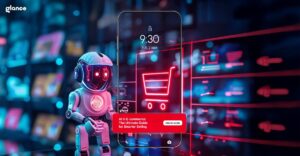Global AI Trends in Shopping
Artificial intelligence is no longer an experimental add-on in shopping — it’s the engine quietly redesigning the whole customer journey, supply chain, and product lifecycle. From the way you discover a product (snap a pic, get a match), to how stores predict inventory and personalize promotions, AI is reshaping every stop between desire and purchase. This article examines the most consequential global AI trends in shopping for 2024–2025 and beyond: what’s being deployed now, why it matters, and how retailers and consumers should prepare.
1. Personalization at scale: the shift from segment-based to one-to-one
Personalization used to mean “people who bought X also bought Y.” Today it’s far deeper: AI combines first-party shopper behavior, real-time signals (browsing, clicks, returns), and contextual data (time of day, device, weather, location) to produce individualized product selections, pricing, and messaging. Retailers are redesigning onsite and app experiences so every element — hero banners, search results, push notifications — can be dynamically tailored to the individual.
Why it matters: brands that get personalization right see higher conversion rates, larger baskets, and longer lifetime value. McKinsey’s recent work shows organizations investing in AI to redesign workflows and governance see measurable bottom-line impact as they operationalize generative and predictive models. McKinsey & Company
Practical examples: dynamically generated email subject lines, AI-curated homepages that change per user, and personalized bundles created via generative models for cross-sell recommendations.
2. Conversational commerce and AI shopping assistants
Conversational commerce — chatbots, voice agents, in-app assistants — has matured from scripted FAQ bots to context-aware shopping helpers that can search inventory, compare products, and complete purchases. Advances in large language models and retrieval-augmented generation (RAG) allow assistants to answer nuanced questions (“Which running shoes are best for supination and budget under $120?”), reference up-to-date inventory, and even propose meal plans or outfits customized to the user.
Retailers are moving beyond basic chatbots to “shopping agents” that can act on behalf of users: add-to-cart, price-watch, and even autonomously complete repeat purchases. This agentic direction — where agents make multi-step decisions within set constraints — is already a strategic priority for leading retailers. For example, large grocers and big-box chains are piloting agentic workflows inside apps to speed replenishment and ease repeat buying. Barron’s
3. Visual and multimodal search: buy what you see
Visual search converts images into product matches. Point your camera at a jacket on the street or a couch on Instagram and AI returns visually similar items, sometimes with near-identical matches. Multimodal models combine image, text, and user preference signals to make these matches more accurate and relevant.
Why it’s trending: consumers increasingly shop visually — social platforms, short videos, and image-rich marketplaces make visual search a natural step. Visual search removes the “vocabulary gap” (when you can’t find the right keywords), increasing discovery and reducing drop-off. Industry roundups in 2025 highlight visual search as one of the fastest-growing ways customers discover products online. Feedonomics
Practical edge: retailers that tag products with richer embeddings (not just SKU attributes but style embeddings) get better match rates and higher click-through for image-driven traffic.
4. Generative AI for creative content and product design
Generative AI has moved from demo-showcases into production use: retailers use it to generate marketing copy, product descriptions at scale, social media assets, and even initial product sketches and pattern ideas for apparel. This accelerates time-to-market and reduces creative bottlenecks.
Use cases:
-
Automated A/B variants of product descriptions tailored to audience segments.
-
On-demand ad creative scaled across geographies and languages.
-
Rapid prototyping: designers seed generative models with trends and customer preferences to brainstorm product variations.
Generative systems also free human creatives to focus on high-level strategy and refinement rather than routine content creation — but they require strong guardrails for brand voice, factual accuracy, and IP safety. Industry analyses emphasize generative AI as a cornerstone for content and design pipelines in retail today. Publicis Sapient
5. Inventory optimization and demand forecasting — smarter, faster, leaner
AI-driven forecasting and inventory optimization are moving from “nice to have” to mission critical. Modern systems ingest POS data, promotions, weather forecasts, social trends, supplier lead times, and macro indicators to produce probabilistic demand forecasts. These predictions feed automated replenishment systems, warehouse labor planning, and dynamic allocation across stores.
Why this trend accelerates now: better models, more compute, and richer data pipelines allow retailers to reduce stockouts and markdowns simultaneously — the classic retail tradeoff. Quid’s 2025 analysis shows product recommendations, inventory management, and AI agents are among the most discussed and adopted themes in e-commerce conversations, suggesting practical uptake across the industry. quid.com
6. In-store AI: cashierless checkouts, heatmaps, and smart shelving
Physical retail is not immune to the AI wave. Computer vision and edge AI power frictionless checkout (scanless and cashierless stores), customer flow analysis (heatmaps showing dwell time and congestion), and smart shelving that alerts staff when items run low or shifts are needed.
These systems improve labor allocation and the in-store experience — for example, proactively opening checkout lanes when congestion rises or pushing live promotions to nearby shoppers. For omnichannel retailers, bridging online and offline data is crucial: connecting in-store behavior to customer profiles enhances personalization and attribution.
7. AR/VR try-ons and “phygital” experiences
Augmented reality (AR) try-ons for apparel, eyewear, makeup, and furniture reduce return rates by letting customers preview fit and look before purchase. Mixed reality showrooms and virtual storefronts are also emerging, particularly for luxury and furniture brands where visualizing scale and ambiance matters.
AR blends with personalization: try-on filters can be adjusted by skin tone, body measurements, or home dimensions (for furniture), creating a much more confident online shopping decision.
8. Fraud prevention and secure payments using AI
AI’s pattern recognition capability is indispensable for fraud detection: machine learning models evaluate transactions in real time to detect unusual behavior, bot activity, and chargeback risks. As payment methods diversify (wallets, BNPL, tokenized cards), AI helps distinguish high-risk patterns without disrupting legitimate shoppers.
Large cloud providers and fintech partners are shipping specialized models for payment risk and identity verification, accelerating adoption among mid-size merchants that previously lacked resources to build their own detection engines.
9. Supply-chain resilience and risk modeling
Retailers are investing in AI to simulate disruptions (supplier failure, port delays, raw material price spikes) and to recommend mitigation strategies. The models are used for scenario planning (what happens if a supplier is down for X days?) and dynamic re-routing of inventory in near real-time.
This trend reflects a post-pandemic reality: retailers now expect volatility, and AI provides the speed and foresight necessary to adapt quickly.
10. Responsible AI, data governance, and privacy: a non-negotiable
With personalization and predictive analytics comes responsibility. Consumers and regulators expect transparent data use, clear opt-outs, and secure handling of personal data. Companies are building governance frameworks (model cards, auditing, human oversight) to ensure compliance and fairness. McKinsey and others recommend embedding governance into AI deployments early — not as an afterthought. McKinsey & Company
Two practical governance points:
-
Document model lineage and datasets (so you can explain and audit recommendations).
-
Use privacy-preserving methods (on-device inference, federated learning, differential privacy) where feasible.
11. The rise of verticalized AI platforms and retail partnerships
Rather than building everything in-house, many retailers partner with specialty AI vendors or leverage verticalized AI platforms tailored to retail needs (visual search APIs, personalization engines, inventory optimizers). Cloud providers and retail-focused startups offer pre-trained models adapted to merchandising, fraud, and logistics — enabling faster adoption and reducing experimentation costs. Google Cloud and others publish retail trend resources and toolkits that accelerate adoption by combining domain knowledge with scalable infrastructure. Google Cloud
12. Global implications: winners, laggards, and inequality risks
AI in shopping is not equally distributed. Wealthier markets and large brands — with abundant data and engineering talent — can extract disproportionate value from advanced AI. International organizations have warned that without inclusive access to AI infrastructure and skills, disparities could widen between high- and low-income economies. This has implications for global trade, sourcing, and market competition. Retailers operating globally should therefore consider local constraints: data localization laws, latency, language coverage, and infrastructure differences. Financial Times
13. What this means for brands and operators: tactical playbook
For retailers and brands wondering where to start or scale up, here’s a pragmatic roadmap:
-
Prioritize high-impact use cases: personalization, inventory optimization, and fraud prevention are proven value drivers.
-
Invest in first-party data hygiene: clean, privacy-compliant customer profiles are the fuel for effective models.
-
Start with modular pilots: deploy AI components (search, product descriptions, forecasting) that connect to your stack before attempting monolithic changes.
-
Build governance early: model audits, human-in-the-loop, and transparency reduce regulatory and reputational risk.
-
Choose partners carefully: prefer vendors that understand retail domain constraints (returns, seasonality, supply-chain timings).
-
Upskill staff: domain analysts and ops teams must be fluent enough to interpret model outputs and translate them into action.
14. What consumers should expect
Buyers will see more frictionless discovery (visual and conversational search), more relevant offers, and overall faster checkout flows. However, personalization trade-offs will become more visible: consumers will need clearer controls over how data are used and better interfaces to manage preferences. Expect more choice in privacy (on-device experiences, limited tracking options) as brands compete on trust as well as price and convenience.
15. Risks and trade-offs
AI in shopping carries risks:
-
Bias in recommendations (recommending higher-margin items over suitable alternatives).
-
Overpersonalization that traps customers in narrow “filter bubbles.”
-
Data breaches if governance is weak.
-
Market concentration: large retailers with access to vast datasets can widen competitive moats.
Smart strategies mitigate these — e.g., auditing recommendation diversity, offering manual overrides, and transparent user controls.
16. Looking ahead: 3 strategic bets for the next 3–5 years
-
Agentic shopping assistants will proliferate. Agents that can manage repeat purchases, negotiate bundles, and act on schedule will change purchase frequency and loyalty dynamics. Barron’s
-
Multimodal discovery becomes the default. Visual, voice, and text search fused into single pipelines will make discovery seamless across channels. Feedonomics
-
Retail AI ecosystems will standardize. Expect a clearer separation: horizontal infrastructure (cloud, payments), vertical AI services (visual search, personalization), and integrators that stitch them together — lowering barriers for mid-market retailers. Google Cloud
Conclusion
AI is reshaping shopping from the storefront to the supply chain. The winners will be retailers that combine data cleanliness, smart use cases, responsible governance, and the agility to partner where it makes sense. For consumers, the near future promises more relevant, visual, and conversational ways to shop — but also a renewed focus on trust and control. As AI capabilities expand, the retail industry faces a pivotal moment: invest strategically, govern wisely, and design experiences that serve people as much as they serve profit.
For quick updates, follow our whatsapp –
https://whatsapp.com/channel/0029VbAabEC11ulGy0ZwRi3j
https://bitsofall.com/https-yourdomain-com-google-gemini-in-chrome-future-of-ai-powered-browsing/
https://bitsofall.com/https-yourblog-com-bringing-ai-agents-into-any-ui/
Physical AI: Bridging the Gap Between Artificial Intelligence and the Physical World








